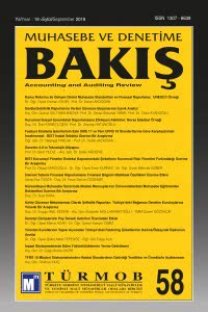EKONOMİK KATMA DEĞERİN DİĞER PERFORMANS ÖLÇÜLERİNE GÖRECELİ ÜSTÜNLÜĞÜ; TÜRKİYE ÖRNEĞİ
Ekonomik Katma Değer (EKD), Piyasa Katma Değeri (PKD), Hisse Senedi Getirisi, Artık Kar
THE RELATIVE SUPERIORITY OF ECONOMIC VALUE ADDED TO OTHER PERFORMANCE MEASUREMENTS; AN EXAMPLE OF TURKEY
___
- ARGUN, D. (2004) Ekonomik Katma Değer, Muhasebe ve Denetime Bakış, Yıl:4, Say:11, Ankara.
- BAO, B. ve BAO, D. (1998) Usefulness of value added and abnormal economic earnings: an empirical exami- nation, Journal of Business Finance & Accounting, Vol. 25, no. 1/2, , pp. 251–64.
- BIDDLE, G.C., BOWEN, R.M. ve WALLACE, J.S. (1997) Does EVA beat earnings? Evidence on associations with stock returns and firm values, Journal of Accounting and Economics, Vol. 24, December.
- ÇELİK, O. (2002) İşletmede Bir Performans Ölçütü Olarak Ekonomik Katma Değer (EKD) ve Türk Telekom
- A.R. de Uygulaması”, MÖDAV Muhasebe Bilim Dünyası Dergisi,Cilt: 4 Sayı:1. CHEN, S. ve DODD, J. L. (1998) Usefulness of operating income, residual income and EVA: a value-relevance perspective, Working Paper, Clarion University and Drake University.
- DODD, J.L. ve CHEN, S. (1996) EVA: A new panacea? B & E review, July – September: 26-28.
- FERNANDEZ, P. (2001) EVA, economic profit and cash value added do not measure shareholder value creati- on, Working Paper, IESE Business School – University of Navarra.
- FINEGAN, P.T. (1991) Maximizing shareholder value at the private company, Journal of Applied Corporate Fi- nance, 4(1), Spring: 30-45.
- GÖKÇEN, G. (2004) Ekonomik Katma Değer (EVA), MUFAD Muhasebe ve Finansman Dergisi, Sayı:24, ISSN 0391, 105-109, İstanbul
- GRANT J. L. (1996) Foundations of EVA for investment managers, The Journal of Portfolio Management, Vol , 41-48
- HALL, J.H. (1998) Variables determining shareholder value of industrial companies listed on the Johannesburg
- Stock Exchange, Doctoral thesis, University of Pretoria, Pretoria. ISMAIL A. (2006) Is Economic Value Added More Associated With Stock Return Than Accounting Earnings?
- The UK Evidence International Journal of Managerial Finance, Vol. 2 No. 4, pp. 343-353
- KAYO E., BASSO L.C. ve OLIVEIRA S.F. (2005) The Major Accounting Adjustments to Calculate EVA : An
- Application to Brazilian Firms, Working Paper, SSRN: http://ssrn.com/abstract=677582
- KORKMAZ T.K. ve ÖZDEMİR M.A. (2003) Ekonomik Katma Değer – EVA Nedir ?, Active Dergisi, No:33, http://www.activegroup.biz/active/active.html
- KYRIAZIS D. ve ANASTASSIS C. (2007) The Validity of the Economic Value Added Approach: An Empirical
- Application, European Financial Management 13 (1), 71–100 LEHN, K. and MAKHIJA, A. K. (1996) EVA & MVA as performance measures and signals for strategic chan- ges, Strategy & Leadership, 24, 34–38, May/June.
- LEHN, K. and MAKHIJA, A.K. (1997) EVA, accounting profits, and CEO turnover: an empirical examination 1994, Journal of Applied Corporate Finance, Vol. 10 No. 2, pp. 90-7.
- MAKELAINEN, E. (1998) Economic value added as a management tool, 1-57, http://www.evano- mics.com/evastudy/evstudy.shtml Accessed 6 January 2008.
- MILUNOVICH, S. ve TSUEI, A. (1996) EVA in the Computer Industry, Journal of Applied Corporate Finance (No. 1, spring), 104-115
- MOURITSEN, J. (1998) Driving Growth: Economic Value Added Versus Intellectual Capital, Management Ac- counting Research, 9, 461-482
- O’BYRNE, S. F. (1996) EVA and market value, Journal of Applied Corporate Finance, 9, 116–25.
- O’HANLON, J. and PEASNELL, K. (1998) Wall Street’s contribution to management accounting: the Stern Ste- wart EVA financial management system, Working Paper, Lancaster University, Lancaster.
- PARLAKKAYA, R. (2003) Maliyet ve Performans Yönetim Aracı Olarak Tümleşik Faaliyet Tabanlı Maliyetle- me ve Ekonomik Katma Değer Sistemi, Afyon Kocatepe Üniversitesi, I.I.B.F. Dergisi, C.V, S.2
- PEIXOTO, S. M. (2002) Economic Value Added - Application to Portuguese Public Companies, SSRN: http://ssrn.com/abstract=302687
- PETERSON, P. P. ve PETERSON, D. R. (1996) Comparison of Alternative Performance Measures, The Rese- arch Foundation of the Institute of Chartered Financial Analysts.
- RAMANA, D.V. (2005) Market Value Added and Economic Value Added: Some Empirical Evidences, 8th Ca- pital Markets Conference, Indian Institute of Capital Markets Paper
- ŞAMİLOĞLU F., 2004. “Ekonomik Katma Değer: İMKB’de Örnek Olay İncelemesi?, MUFAD Muhasebe ve Fi- nansman Dergisi, Sayı:24, ISSN 1304-0391, 150/157, İstanbul.
- ŞAMİLOĞLU, F. (2005) Performans Ölçümünde EVA ve MVA : İstanbul Menkul Kıymetler Borsası’ndaki Şir- ketlerde Ampirik Bir Uygulama, Hacettepe Üniversitesi İktisadi ve İdari Bilimler Fakültesi Dergisi, 2, 163/174.
- STERN Stewart and Co. (1999) http:/www.sternstewart.com/about_eva\about_eva_main.html Accessed Febru- ary 1999
- STERN, J. (1993) Value and people management, Corporate Finance, July:35-37.
- STEWART III, G. B. (1994) EVA: fact or fantasy?, Journal of Applied Corporate Finance 7, 71-84.
- STEWART, G. B. (1991) The quest for value, Harper Business, New York
- TSUJI, C. (2006) Does EVA beat earnings and cash flow in Japan ? , Applied Financial Economics, 16:16, 1199 1216
- UYEMURA, D. G., KANTOR, C. C., ve PETTIT, J. M. (1996) EVA for banks: value creation, risk management, and profitability management, Journal of Applied Corporate Finance, 94–113.
- WEST T. ve WORTHINGTON A. (1999) The information content of economic value-added: a comparative analysis with earnings, cash flow and residual income, School of Economics and Finance Discussion Papers and Working Papers Series 066.
- ISSN: 1307-6639
- Yayın Aralığı: 3
- Başlangıç: 2000
- Yayıncı: TÜRMOB
ULUSLARARASI STANDARTLAR ÇERÇEVESİNDE DENETİM VE BENZERİ HİZMETLER
STRATEJİK PERFORMANS ÖLÇMEDE DENGELİ SONUÇ KARTI: BİR SANAYİ İŞLETMESİNDE UYGULAMA
Veyis Naci TANIŞ, M Fatih GÜNER
Hüseyin ERGİN, Şerafettin SEVİM, Ayşenur ELİUZ
ADLİ MUHASEBE VE ADLİ MUHASEBECİLİK MESLEĞİ
EKONOMİK KATMA DEĞERİN DİĞER PERFORMANS ÖLÇÜLERİNE GÖRECELİ ÜSTÜNLÜĞÜ; TÜRKİYE ÖRNEĞİ
HİLELİ FİNANSAL RAPORLAMA YAKLAŞIMLARINI BELİRLEYEN TEŞVİKLER/BASKILAR ve FIRSATLAR
